
Now You See Me is a group exhibition that brings together six artists—Jerry Takigawa, Priya Kambli, Tommy Kha, Jennifer Ling Datchuk, Leonard Suryajaya, and Tomiko Jones—who offer a glimpse into the vast complexity and nuance of Asian America. While diverse in scope, works in the show share a common thread: an urge to be seen and recognized through personal narratives put forth on one’s own terms—all set against the backdrop of a country that didn’t coin the phrase ‘Asian American’ until 1968, and a country that continues to overlook Asian Americans in the public sphere.
For Jerry Takigawa and Priya Kambli, inherited photographs become artifacts that connect the artists with past family traumas worth remembering for the lessons they hold. For Tommy Kha, Jennifer Ling Datchuk, and Leonard Suryajaya, staged tableaus brimming with material objects—be they cardboard cutouts of Kha’s face, Datchuk’s irreverent blue-and-white porcelain pieces, or Suryajaya’s indulgent excesses of colorful fabrics and household items—call on the dynamic intersections of contemporary Asian America with aspects of sexuality, gender, cross-cultural understanding, and belonging. In turn, Tomiko Jones’ photographed performance of a Japanese memorial ritual for her father circles back to tradition, lending a quiet vulnerability to the fray.
With all of this, Now You See Me pushes for the inclusion of each artist’s voice—alongside those of countless other Asian American and minority creatives—into the American canon.
In 1968, students at UC Berkeley invented the term Asian American to inaugurate a new political identity. Radicalized by the black power movement and anti-colonial movement, the students invented that name as a refusal to apologize for being who they were. It’s hard to imagine that the origin of Asian America came from a radical place, because the moniker is now flattened and emptied of any blazing political rhetoric. But there was nothing before it. Asians either identified by their nationality or were called Oriental. The activist Chris Iijima said, “It was less a marker for what one was and more for what one believed.” (1)
Cathy Park Hong
I did not yet exist when the Asian American Political Alliance (AAPA) was founded at Berkeley in May of 1968—but I was, slowly but surely, on my way. Within a little over a decade after Yuji Ichioka, Emma Gee, and their friends came together as AAPA and coined the term “Asian American,” both of my parents had arrived in the United States from Hong Kong. By the mid 80s, each had earned an undergraduate and a graduate degree apiece. My sister was born in 1991, I followed suit in 1996, and my parents were granted U.S. citizenship somewhere in between. Being foreign-born, becoming citizens was the most tangible way for my parents to solidify their status as Asian Americans—if we are to define Asian Americans in the broad, textbook way we often do today: as Americans of Asian ancestry.
In the interest of troubling this definition and channeling the activist realm from which the term Asian American originates, I have to wonder: when did my parents stop feeling and being seen as foreigners and cross into the threshold of feeling and being seen as Asian American? I don’t believe it was when they officially obtained citizenship; in fact, I hold that the two of them could have been considered Asian Americans—and Americans, for that matter—long before acquiring that kind of official permanency. I like to imagine that their foray into Asian America perhaps began the moment they ate their first hamburgers, or shoveled their first snow from the pathway leading up to their small, brick house. By now, my parents have lived in the United States for over twice as long as they ever lived in their native Hong Kong.
Things are a little more concrete for my sister and me: we, alongside many of our peers born here in the States, have been a part of diasporic Asian America since our respective day ones (sending me ‘back to where I came from’ would only banish me to the suburbs of New Jersey). Though American on paper, however, we are still not immune to the effects of racial othering entrenched in this country. Some Asian Americans are fetishized, others are desexualized and emasculated (2, 3). Some of us are physically brutalized, subject to harassment, and whitewashed from narratives (5, 6).
In response, we are expected to take the high road: tolerate, bow our heads, work hard, achieve. Like our immigrant predecessors, we live “a conditional existence in which belonging is promised as long as we work harder at being good, […] internalizing any racial slights we encounter.”6 When we do break ground, we are celebrated as America’s model minority—for overcoming the barriers to entry designed by the very same people who sing our praises. Our successes—which are pointed to as a sign that the American Dream meritocracy is alive and well—are then used to denigrate other minorities, including Black Americans (7). This ultimately reinforces a double-edged exceptionalism in which the material wealth, influence, and stability we accrue encourage us to perpetuate a system that harms historically disadvantaged and marginalized Black, brown, and Indigenous communities (8).
With regard to anti-Asian American backlash stemming from the coronavirus pandemic, former presidential candidate Andrew Yang penned a call to action for Asian Americans “to embrace and show our Americanness in ways we have never before” (9). This, in the wake of Asian Americans being spat on, harassed, and stabbed (10, 11, 12). While something akin to admirable in its intent, Yang’s patriotism rings hollow for a community that has long grown tired of jumping through hoops to prove how American we are.
My urge to expound upon these issues—and dedicate an exhibition to them—is largely born out of something writer and comedian Hasan Minhaj calls the “audacity of equality.” As part of the first+ generation born here in the States, I have the luxury of birthright citizenship—meaning that instead of having to adapt and play by the rules of another country’s system for basic survival, I am able to agitate for more on my home turf. Minhaj’s “audacity of equality” manifests itself in me—and other Asian Americans—as both an ingrained sense of entitlement to the rights, freedoms, and protections theoretically bestowed upon American citizens, and an insatiable hunger for proper and diverse representation across all platforms, be they in relation to media, governmental bodies, cultural institutions, and the like.
Keeping this in mind, I advocate for reading the term Asian American as two-part: as not only a category for demographic purposes, but also as an ongoing acknowledgement that our histories, our everydays, and our futures are unequivocally American. While the first, indexical interpretation of the term can be useful, it is also imperfect and incomplete: it’s geographically ambiguous (where does Asia begin and end?), it’s typically biased towards East Asians, and it makes us appear like a monolith when we are anything but.
Now You See Me leans toward the latter approach: instead of using the term Asian American to pigeonhole us into a neat, encyclopedic definition, perhaps we embrace the phrase’s boundlessness—however unruly it may be. Perhaps we dive headfirst into the sprawling dissonance, guided by a group of artists who illuminate compelling avenues of personal engagement with Asian America at large.
Jerry Takigawa
With an eye toward recent history and its direct impact on the present day, Jerry Takigawa and his series Balancing Cultures delve into the internment of Japanese Americans during World War II. In 1942, President Roosevelt’s Executive Order 9066 authorized the establishment of military zones in the United States, leading to the incarceration of Japanese Americans, German Americans, and Italian Americans in concentration camps. For Takigawa’s immigrant grandparents and American-born parents, this government-sanctioned condemnation of their community read as a stark rejection from the country they called home.
In Balancing Cultures, Takigawa engages with this personal family narrative, building and photographing temporary collages assembled from his relatives’ collection of photographs, papers, and war memorabilia from their imprisonment. Layering family artifacts and historical documentation atop blurred, black and white family portraits, Takigawa’s works underscore the contradictions in his family’s existence: wanting to embrace their Japanese heritage while being made to feel ashamed of it through institutional means. While the internment of Japanese Americans ended in March of 1946, the exclusionary ideologies behind it remain at play today for so many—rendering Takigawa’s reach into the past as timely as ever.
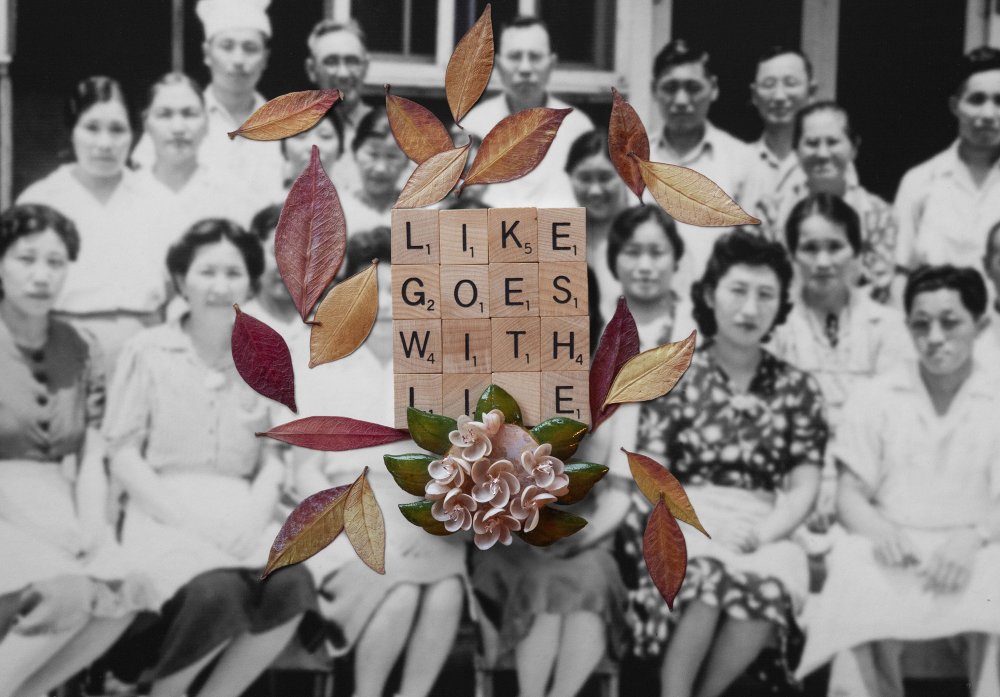
© Jerry Takigawa, Like Goes With Like (2019)
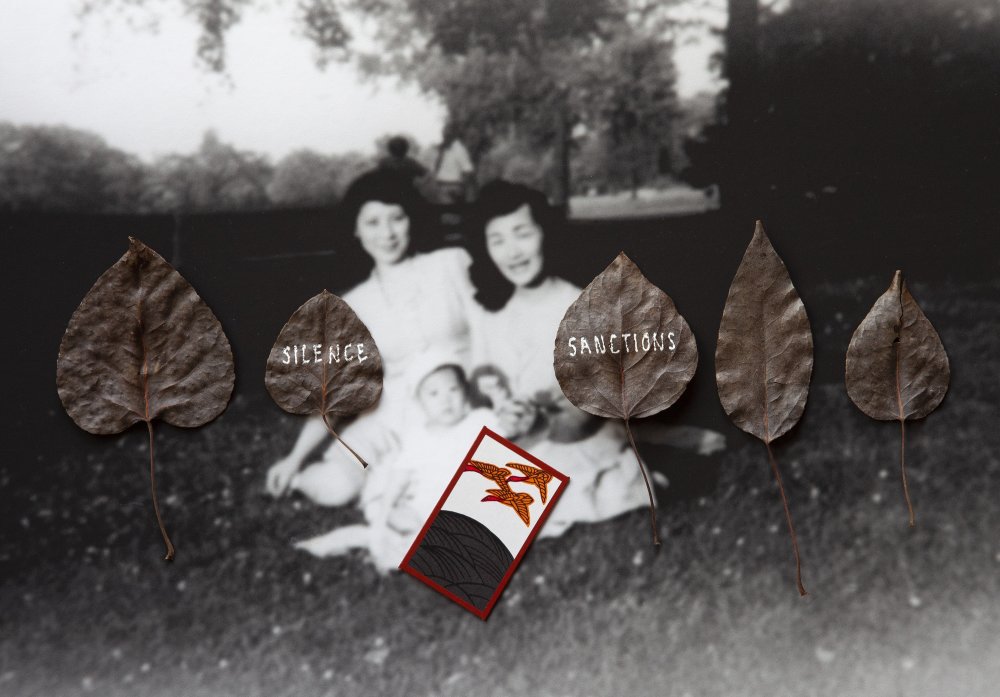
© Jerry Takigawa, Silence Sanctions (2019)
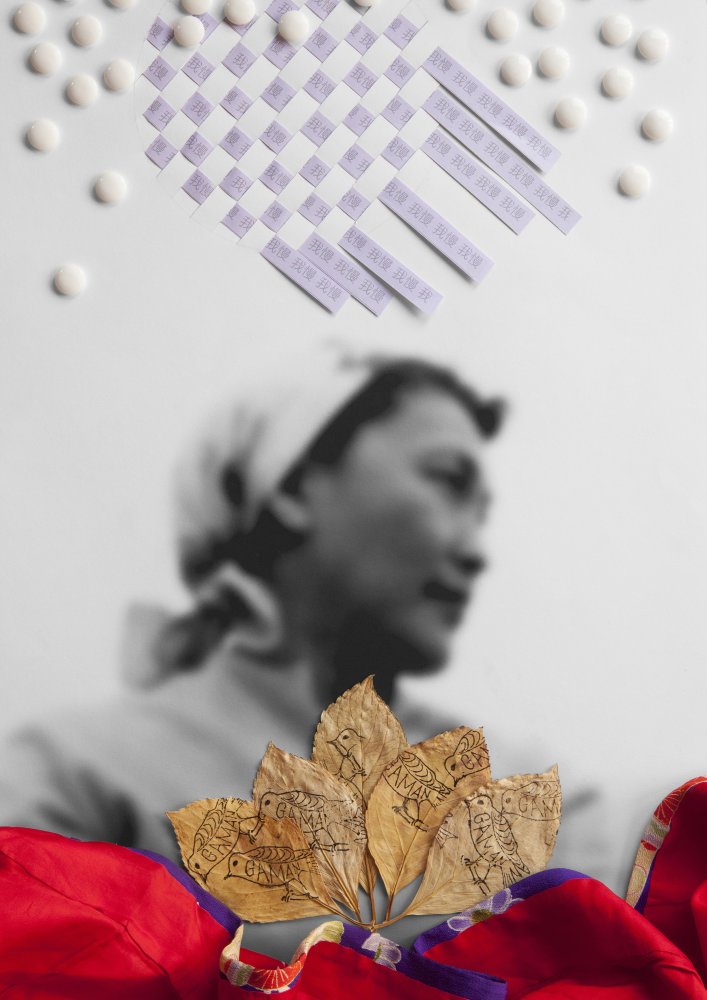
© Jerry Takigawa, Gaman
Priya Kambli
In her series Buttons for Eyes, Priya Kambli presents photographs that revolve around her family narratives, predicated upon her mother’s ever-playful question: “Do you have eyes or buttons for eyes?” While the humor in this query insinuates the receiver’s inability to see an object right in front of their face, it also demonstrates a deeper, expansive concern: that we, as a society, tend to not always be aware of what is happening around us.
In response, Kambli’s offering is simple: look at the world “in more unusual ways.” To this end, the artist broaches large-scale issues of migration, visibility, and cross-cultural understanding through the intimacy of old family photographs. These family relics are adorned with playful interventions—swaths of colored light, delicate geometries of powdered pigment—and then rephotographed. The elusive faces of Kambli’s loved ones appear and reappear, underscoring the artist’s sense of loss for a past that no longer exists, and for a future that will usher in its own set of losses. Despite the heaviness in sentiment, the approach in Buttons for Eyes is still a joyful one—one that “winks, pokes and inverts” the personal histories that it mythologizes.
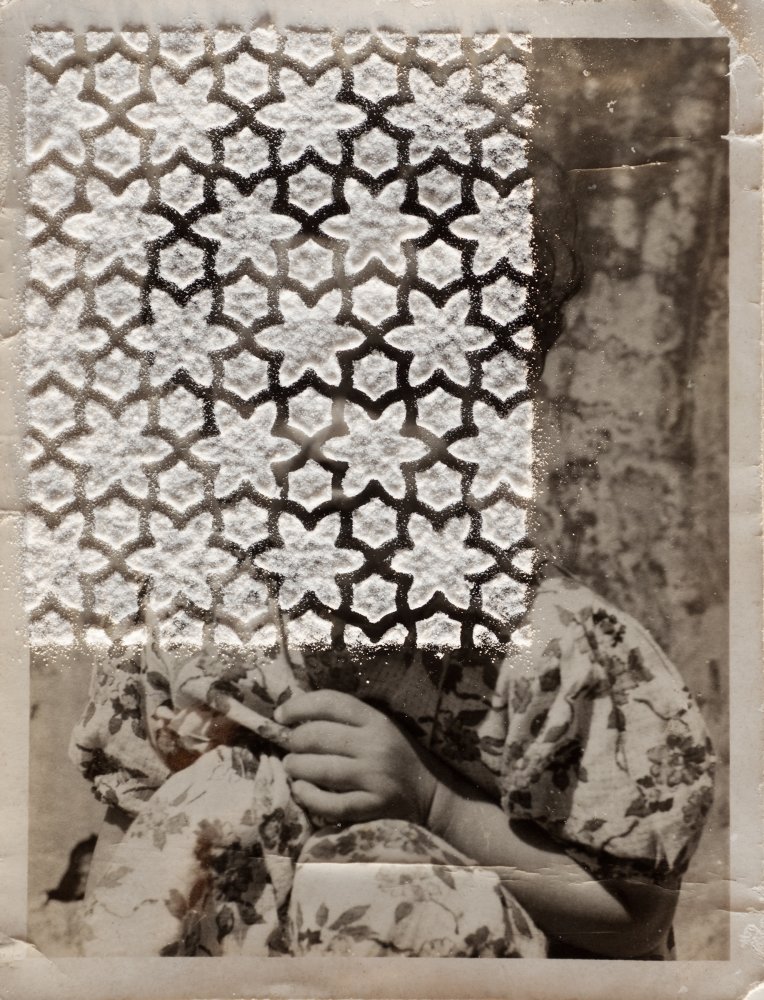
© Priya Kambli, Flour and Flower (2017)
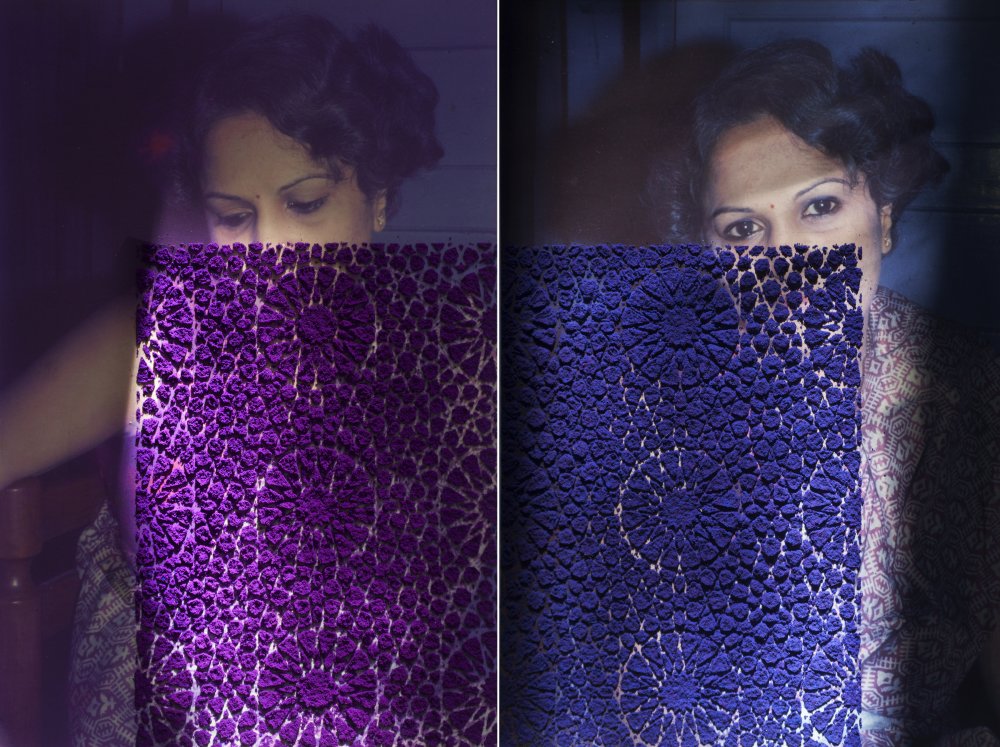
© Priya Kambli, Purple Muma's (2017)

© Priya Kambli, Muma/Muma (2019)
Tommy Kha
Tommy Kha’s imagery employs a whimsical and humorous attitude as it foregrounds the complex angles and intersections of the artist’s identity: Asian American, queer, and raised in the American South. Using various cardboard cutouts and masks bearing the likeness of his face, Kha magically creates self-portraits without ever turning the camera on himself. Instead, his face facades are placed and photographed everywhere else: joined to an Elvis cutout, lurking behind curtains as his mother looks on, plastered to classical era busts, serving as the head atop friends’ idealized bodies.
While Kha’s light-filled and colorful environments may change, his face cutouts typically do not waver from their stoic, deadpan expressions. The ubiquity of the artist’s face turns his likeness into a kind of visual motif, leaving viewers to search for and rely on it as an anchor point tying one work to the next. In this clever and absurd way, Kha ensures that he is distinctly visible in a manner that only he controls—a privilege that is usually not afforded to those at the crossroads of his communities.
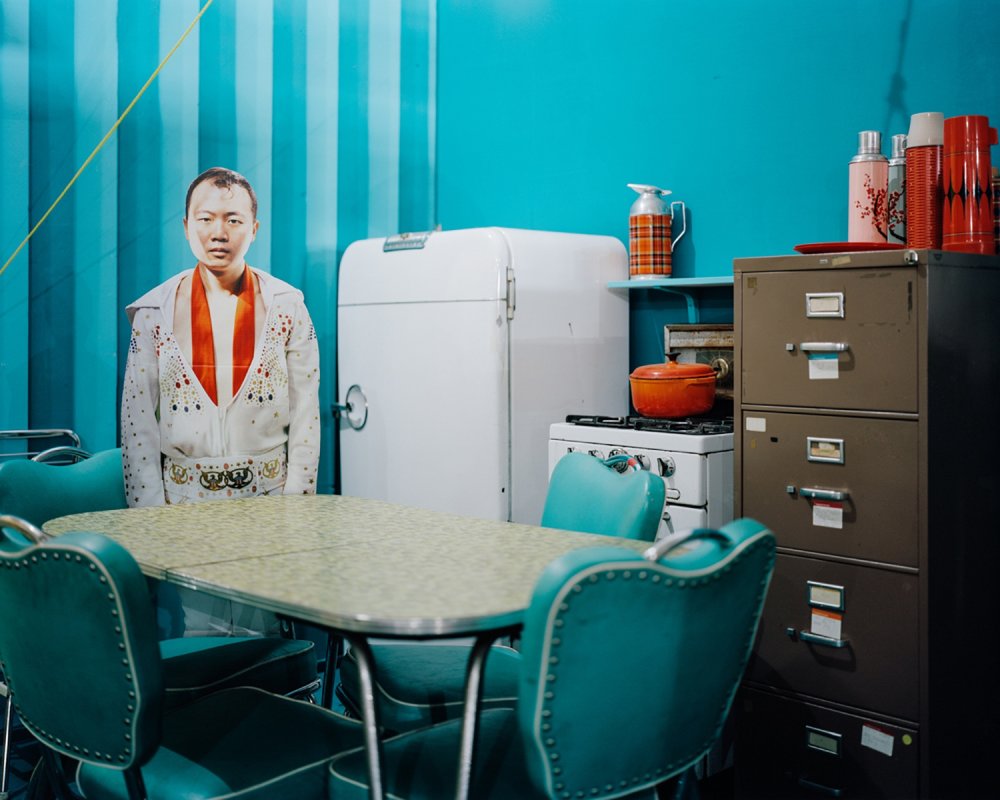
© Tommy Kha, Constellations VIII (2017)
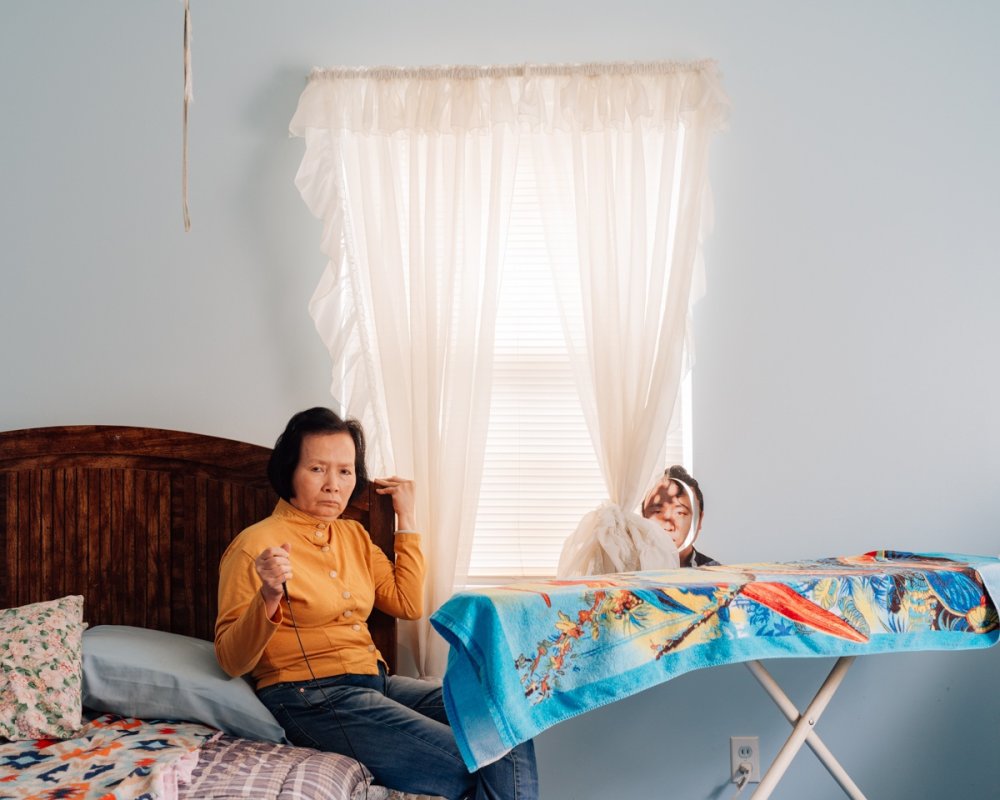
© Tommy Kha, Constellations XVIII (2019)
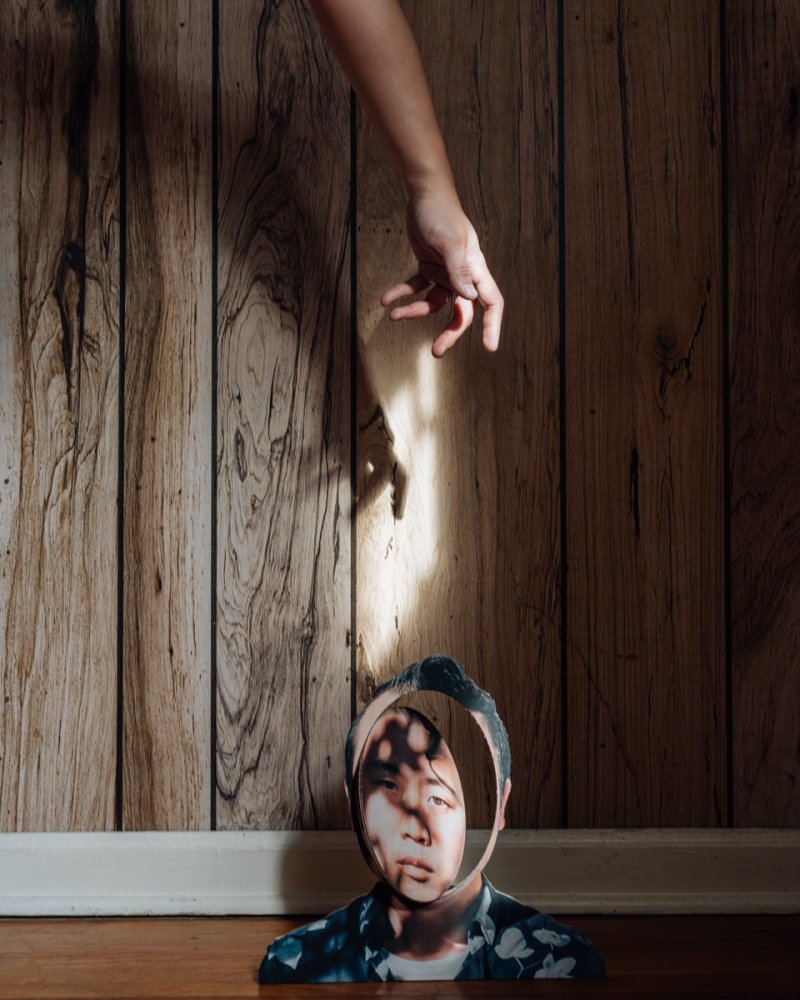
© Tommy Kha, Constellations XIX (2019)
Jennifer Ling Datchuk
A multimedia artist working with everything from ceramics to embroidery to photography, Jennifer Ling Datchuk examines elements of and interactions among femininity, fragility, and identity. Born to a Chinese immigrant mother and a father descended from Russian and Irish immigrants, the artist unpacks the in-between spaces found in being neither fully Chinese nor white. These tensions manifest themselves through Datchuk’s unexpected and quotidian uses of porcelain, which pay homage to, yet also subvert, the legacy, tradition, and poise attributed to Chinese ceramics.
In some images, Datchuk can be seen wearing porcelain eyebrows of her own design, an act which effectively turns body hair—an entity which women are socialized to routinely pluck, shape, and/or process—into an ironically precious object. In other images, the artist presents viewers with fist-sized porcelain rings worn on hands decorated with matching, manicured nails, marrying the classic blue and white aesthetic of Chinese porcelain with an affect steeped in American bravado and consumerism. With storied materials, Datchuk and her pieces spark discussions on globalized politics, cultural cross-pollination, and the commodification and gen-dering of beautiful things.

© Jennifer Ling Datchuk, Basic Bitch (2018)
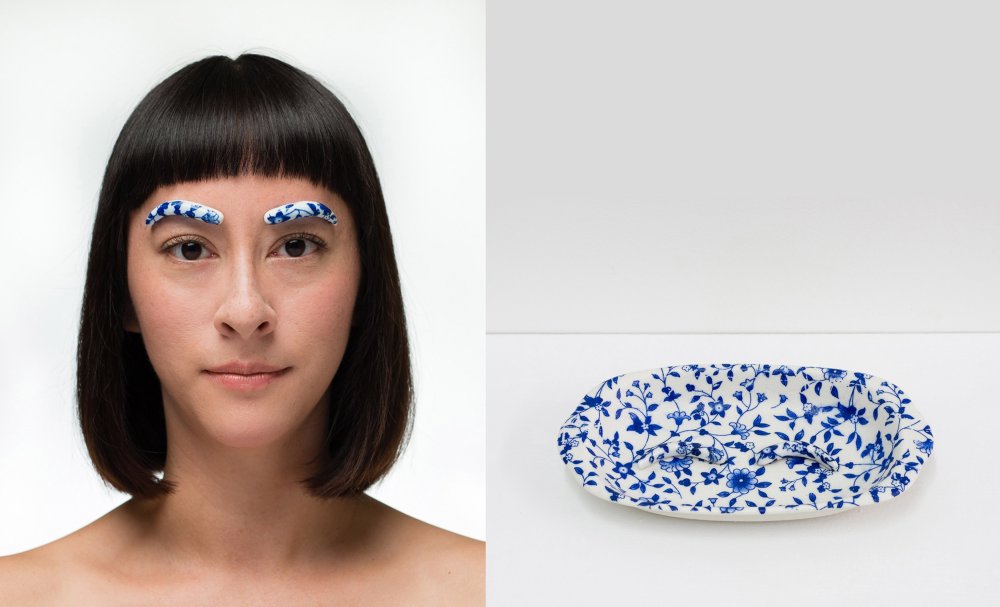
© Jennifer Ling Datchuk, Blue and White: Bold Beauty (2014)

© Jennifer Ling Datchuk, Twist and Curl (2019)
Leonard Suryajaya
There is a dizzying comfort to be found in the domain of Leonard Suryajaya’s spectacular, orchestrated chaos. Creating from an acute familiarity with transience and otherness—Suryajaya is a queer, Chinese-Indonesian immigrant who grew up attending Christian schools in majority-Muslim Indonesia—the artist crafts theatrical scenes filled with clashing patterns, textures, and colors. His photographs are often communal undertakings, featuring his family, friends, and partner as collaborative subjects.
Viewers, too, are invited into these messy moments. While some may find themselves lost in the abundance, there are recognizable sights embedded into the works that resonate all the same: the universal branding of Calvin Klein underwear, plastic flowers and fruits, the soft gesture of a woman’s hand resting atop a younger woman’s sleeping head. These competing—yet also somehow harmonious—aggregations of material objects and human figures reflect back on how the incongruous ways in which we chose to blend in and stand out are constantly in flux. Through this lens, Suryajaya reminds us that our everyday interactions with intimacy, authority, and materiality are inextricably bound to broader questions of citizenship and belonging in an ever-changing, transnational world.

© Leonard Suryajaya, Bella (2016)
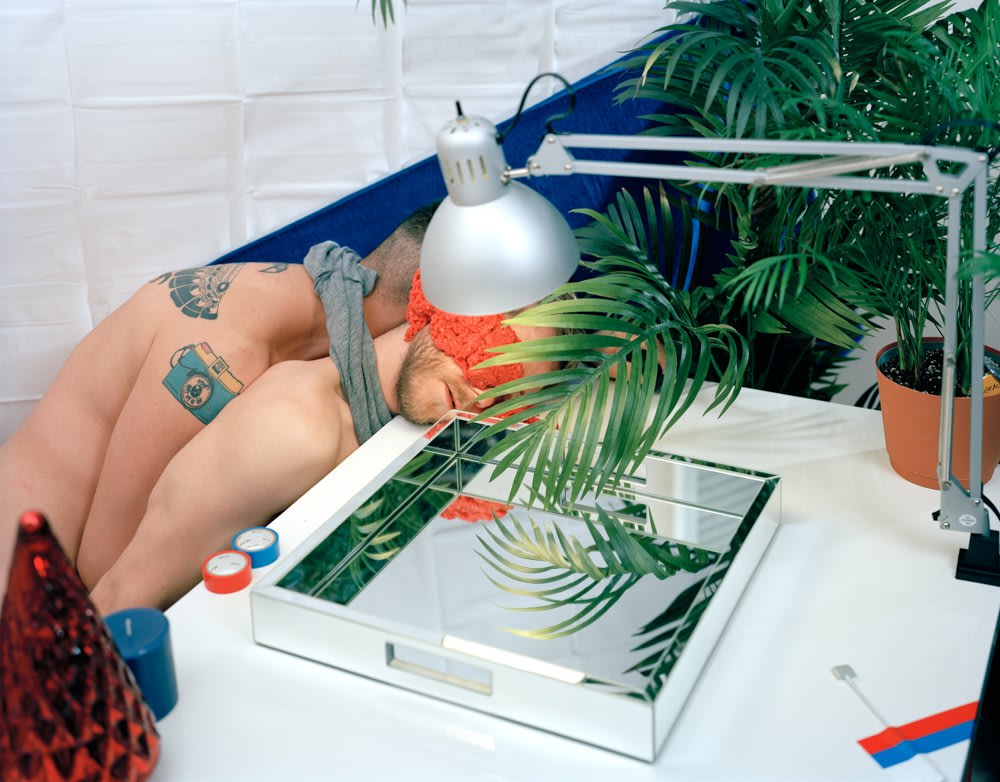
© Leonard Suryajaya, Gap (2015)

© Leonard Suryajaya, Breakfast (2017)
Tomiko Jones
A photographic memorial for Tomiko Jones’ father, Hatsubon hovers in the colliding spaces of ritual and performance. The series is named for a ceremony that marks the first anniversary of a loved one’s death, held as part of O-bon, an annual Japanese Buddhist tradition for honoring one’s ancestors. Associated with O-bon is the sending of the shoryobune, a small vessel meant to guide the spirits of the deceased. It is this act that runs as an undercurrent to Hatsubon: to commemorate her father during O-bon, Jones constructed her own boat from bamboo and waxed kozo paper, sending it to sea at dawn from the shores of Hawai’i, in the company of her mother and sister.
Photographs from those ephemeral moments materialize as vast, black and white landscapes, some printed on floating sheets of silk and some on paper. Other photographs position Jones’ father’s urn afloat in bodies of water significant to the family, including the Monongahela River in her father’s birthplace of Pennsylvania. Figures that appear are silhouetted, blurred, or on the periphery, suggesting a kind of knowing surrender to the land and to the water—one that can only be born out of having a deep, longstanding connection with both from the very beginning. In this way, Hatsubon gives breathing room to tradition in contemporary life.
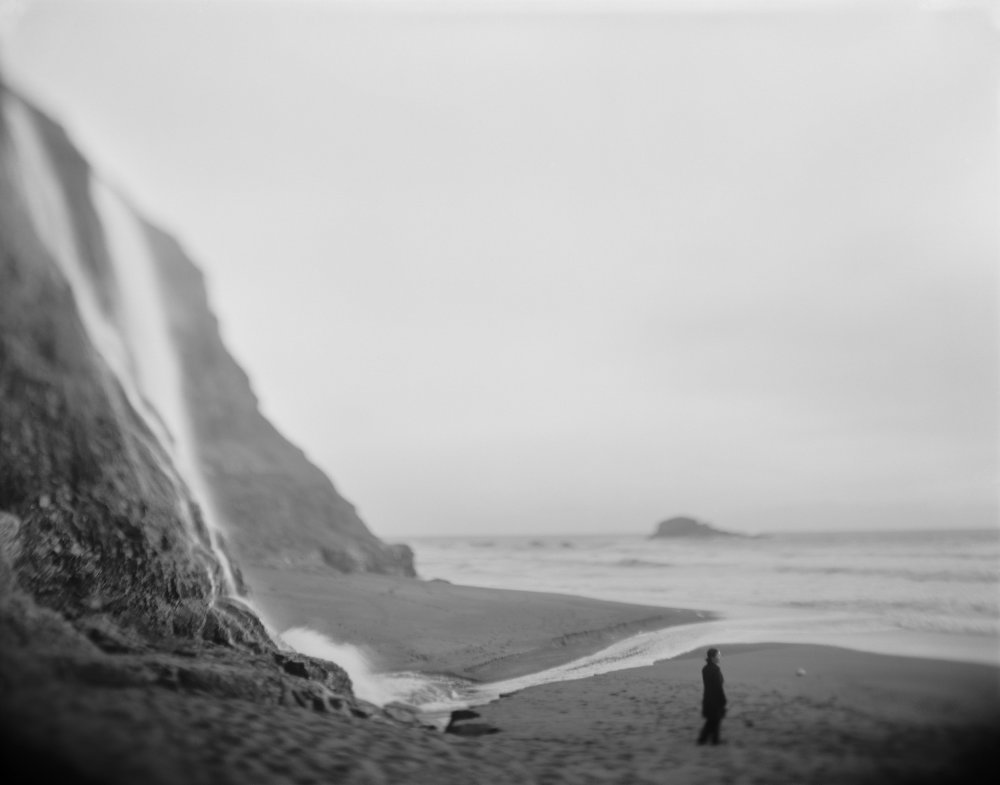
© Tomiko Jones, Alamere (2016)

© Tomiko Jones, River to Sea (2016)

© Tomiko Jones, Shoryobune (2016)
REFERENCES
1 Hong, Cathy Park. Minor Feelings. One World/Random House, 2020.
2 Murray, Georgia. “The Viral Earrings Calling Out Men Who Fetishize Asian Women.” Refinery29, https://www.refinery29.com/en-us/ada-chen-jewelry. Accessed 17 Aug 2020.
3 Rosen, Miss. “Andrew Kung is taking beautiful, intimate portraits of Asian-American men.” Dazed,https://www.dazeddigital.com/art-photography/article/45833/1/andrew-kung-is-taking-beautiful-intimate-portraits-of-asian-american-men. Accessed 17 Aug 2020.
4 Chow, Andrew R. “Violence Against Asian Americans Is on the Rise—But It’s Part of a Long History.” Time, https://time.com/5834427/violence-against-asian-americans-history/. Accessed 19 Aug 2020.
5 Lee, Traci G., Gandhi, Lakshmi. “Hollywood has whitewashed Asian stories for decades. This year, they couldn’t ignore the backlash.” NBC News, https://www.nbcnews.com/news/asian-america/hollywood-has-whitewashed-asian-stories-decades-year-they-couldn-t-n830241. Accessed 19 Aug 2020.
6 Hong, Cathy Park. “The Slur I Never Expected to Hear in 2020.” The New York Times Magazine, https://www.nytimes.com/2020/04/12/magazine/asian-american-discrimination-coronavirus.html. Accessed 17 Aug 2020.
7 “‘Model Minority’ Myth Again Used As A Racial Wedge Between Asians And Blacks.” NPR Code Switch, https://www.npr.org/sections/codeswitch/2017/04/19/524571669/model-minority-myth-again-used-as-a-racial-wedge-between-asians-and-blacks?utm_campaign=storyshare&utm_source=facebook.com&utm_medium=social&fbclid=IwAR1AJv4GdbaeRojvzdjnCIzERHw0wfdOoqBd–Vn6OdB62He6LlqiyZKgDU. Accessed 17 Aug 2020.
8 Nguyen Viet Thanh. “Asian Americans Are Still Caught in the Trap of the ‘Model Minority’ Stereotype. And It Creates Inequality for All.” Time, https://time.com/5859206/anti-asian-racism-america/. Accessed 19 Aug 2020.
9 Yang, Andrew. “Andrew Yang: We Asian Americans are not the virus, but we can be part of the cure.” The Washington Post, https://www.washingtonpost.com/opinions/2020/04/01/andrew-yang-coronavirus-discrimination/. Accessed 17 Aug 2020.
10 Tavernise, Sabrina. Oppel, Richard A. “Spit On, Yelled At, Attacked: Chinese-Americans Fear for Their Safety.” The New York Times, https://www.nytimes.com/2020/03/23/us/chinese-coronavirus-racist-attacks.html. Accessed 17 Aug 2020.
11 “Report: Anti-Asian American Hate in Texas.” Asian Pacific Policy and Planning Council,http://www.asianpacificpolicyandplanningcouncil.org/wp-content/uploads/STOP_AAPI_Report-Texas_7.23.2020.pdf. Accessed 17 Aug 2020.
12 Kim, JuYeon. “Report: Sam’s Club stabbing suspect thought family was ‘Chinese infecting people with coronavirus’.” https://www.ktsm.com/news/report-sams-club-stabbing-suspect-thought-family-was-chinese-infecting-people-with-coronavirus/. Accessed 17 Aug 2020.